- News
- Reviews
- Bikes
- Components
- Bar tape & grips
- Bottom brackets
- Brake & gear cables
- Brake & STI levers
- Brake pads & spares
- Brakes
- Cassettes & freewheels
- Chains
- Chainsets & chainrings
- Derailleurs - front
- Derailleurs - rear
- Forks
- Gear levers & shifters
- Groupsets
- Handlebars & extensions
- Headsets
- Hubs
- Inner tubes
- Pedals
- Quick releases & skewers
- Saddles
- Seatposts
- Stems
- Wheels
- Tyres
- Tubeless valves
- Accessories
- Accessories - misc
- Computer mounts
- Bags
- Bar ends
- Bike bags & cases
- Bottle cages
- Bottles
- Cameras
- Car racks
- Child seats
- Computers
- Glasses
- GPS units
- Helmets
- Lights - front
- Lights - rear
- Lights - sets
- Locks
- Mirrors
- Mudguards
- Racks
- Pumps & CO2 inflators
- Puncture kits
- Reflectives
- Smart watches
- Stands and racks
- Trailers
- Clothing
- Health, fitness and nutrition
- Tools and workshop
- Miscellaneous
- Buyers Guides
- Features
- Forum
- Recommends
- Podcast
TECH NEWS
Just In: 3T Strada - the future just arrived in the road.cc bike shed
The most exciting/radical/groundbreaking/divisive/controversial new bike launched this year is the 3T Strada, a disc-equipped aero road bike built around wide tyres and a 1x drivetrain. You’ll no doubt have seen our first look and first ride video from the launch earlier this year, but we now have an actual bike to test. Here’s a first look before we hit the road.
What the 3T Strada does is bring together a lot of the technology that has pervaded the road bike industry (most of it from the mountain bike side) in the past few years, and bring its all together in one cohesive package. We're talking disc brakes, wide tyres, an aero frame and 1x11 drivetrain. Some people are talking about this being the future of road bikes, which it well may be, but rather more conservatively, it at least offers another choice if you're into your cutting-edge tech.
- 14 of the best and fastest 2018 aero road bikes — wind-cheating bikes with an extra turn of speed
3T is now being handled in the UK by Saddleback, who also look after Enve, Silca, Chris King, Rotor and other high-end brands, and they’ve just built this bike up for us to test. It’s actually one of the very first bikes they’ve built and when they asked if we’d like to be one of the first to ride it, we leapt at the chance. I was down to their HQ like a shot.
It’s a suitably high-end build, as you’d expect on a frameset that costs £3,600. There are the latest Shimano Dura-Ace R91070 Di2 brake levers combined with an XT Di2 rear mech - not a typical combination but I’ve ridden a few adventure bikes with this sort of build, but this is the first time I’ve seen it on a road bike.
Enve 5.6 wheels are shod with Continental GrandPrix 4000 28mm tyres, an aero Enve handlebar, 3T stem and seatpost and Fizik Aliante saddle complete the build. This size medium bike weighs 7.7kg (16.97 lb).
It’s likely that most people interested in the Strada will spec their own dream build, but Saddleback will also be supplying a 3T build kit costing £3,850 (on top of the price of the frameset) that comprises an SRAM Force CX1 groupset with the Quarq Prime crankset, 3T Discus C60 Team wheels and 3T parts.
But there's only one chainring?
The Strada is designed specifically for a 1x groupset, there is no way of fitting a front mech. That is, without doubt, the most divisive design element of the new bike, and it’s borne of a desire to improve the aerodynamics around the bottom bracket area.
But what does it mean for the gearing choice? This bike has an 11-40t cassette and a 48t chainring, a Wolf Components ring with narrow/wide teeth intended to increase chain retention and stop it bouncing off on bumpy roads. Let’s put some numbers down to help get our hands around the difference between this and a conventional drivetrain, using a handy gear inch calculator.
The 48t to 11-40t combination on this bike provides a high and low gear of 116.38 and 32.03in respectively. For comparison, a typical 52/36 and 11-28t setup provides a high and low gear of 126.26 and 34.43inches. So you can see you’re not missing on the smallest gears, but loosing out a little at the top-end.
That could be resolved by swapping to a bigger 50t chainring if you’re a speed merchant, and that’s an option I may take up during the review process. There’s also more scope with adjusting the gear range by changing cassettes.
3T has developed its own 9-32 cassettes in two versions, called Bailout and Overdrive, that have been developed to address some of the gaps between sprockets that can occur on such wide range cassettes.
The Bailout has 9-10-11-12-13-15-17-19-22-26-32 tooth sprockets. You’ll notice that the sprockets increase in size just one tooth at a time at the business end of the cassette with an “oh shit this is a steep hill” bailout sprocket at the other end. The Overdrive has a 9-11-12-13-15-17-19-22-25-28-32 configuration aimed at providing evenly spaced gears across the middle of the cassette with that 9-tooth sprocket for keeping the power on during big descents.
The new cassettes won’t be available until December but I’ll definitely be interested in trying them out.
Wide tyres, minimal clearance and disc brakes
That’s a lot of words already on the lack of a conventional drivetrain. The other big design decision is the frame and fork being designed around wide tyres. There’s space for 25 to 30mm tyres, but these 28mm Contis actually measure 31mm.
Yes, clearance is tight, but that’s fully intentional; this is a bike designed to maximise aerodynamics in every way, it’s not designed to be a practical bike for plugging around muddy British lanes in the winter. You can’t fit mudguards. Think of it more as a time trial bike with drop handlebars. It's all about performance, about going as fast as possible. Check out any other aero road bike or time trial bike and you'll notice they have similarly small clearances as well.
I know a lot of people are looking at the disc brakes and wide tyres and automatically assuming that means it's got versatility written all over it. It hasn't. This isn't an endurance bike. It's a race bike. and it will be raced in the professional peloton next year. Lots of eyes will be on Aqua Sport Blue when the first rollout on their new bikes.
The aero approach to the frame and fork is all about offsetting the higher drag of the bigger tyres. The downtube profile, called ArcFoil, is intended to reduce drag in a wide range of real-world wind conditions and it’s wider towards the bottom bracket to better shield the water bottle from the airflow, with two mounting positions available - the lowest is the most aerodynamic if you want to use just a single bottle.
There are disc brakes because, well they are better, and they free up the fork crown to be as low as possible to decrease the frontal surface area, while the rear stays are extremely thin to maximise seated comfort.
The disc brakes use the flat mount standard, and this bike has a 160mm front rotor and 140mm rear rotor, and there are 12mm thru-axles at both ends. All cables and hoses are internally routed, and the seat clamp is also internal, tucked away inside the top tube.
So that ladies and gentleman, is a first look at the latest test bike to arrive in the office. Stay tuned for a full review very soon - this is one bike test you won't want to miss.
And if you've not watched it already, watch Dave and Tony riding the bike up and down some mountains at the launch earlier this year in this video below:
David worked on the road.cc tech team from 2012-2020. Previously he was editor of Bikemagic.com and before that staff writer at RCUK. He's a seasoned cyclist of all disciplines, from road to mountain biking, touring to cyclo-cross, he only wishes he had time to ride them all. He's mildly competitive, though he'll never admit it, and is a frequent road racer but is too lazy to do really well. He currently resides in the Cotswolds, and you can now find him over on his own YouTube channel David Arthur - Just Ride Bikes.
Latest Comments
- mdavidford 2 hours 2 min ago
My mum always told me I'd inherited her 'hobbit feet', though as far as I'm aware we don't have any family in New Zealand.
- cyclisto 2 hours 15 min ago
He is not saying anything wrong. Modern cars with huge screens, super soundproofed and bluetooth phones, enhance you to get distracted.
- andystow 2 hours 20 min ago
Hyponatremia is a real risk even for an amateur cyclist or runner in hot weather. I've bonked from it before, and I was drinking Gatorade the whole...
- Gd29 2 hours 34 min ago
Feather isn't primarily citing a lack of demand like many comments here are suggesting, lamenting a changing industry....
- whosatthewheel 2 hours 47 min ago
Or be consistent and make it read: "A 2023 study from the US also found that SUVs are causing more BICYCLE injuries..." ...
- mdavidford 2 hours 57 min ago
Where everybody uses stones in different ways? 🤔
- wtjs 3 hours 2 min ago
in the UK we have policing which to a greater or lesser extent relies on assistance from members of the public......
- SecretSam 4 hours 20 min ago
So...don't cycle on it. Lots of other routes around that area. Source: I used to work there.
- Steve K 4 hours 39 min ago
My photochromic specs have just turned up in the post today
- Paul J 4 hours 46 min ago
Downhill Alpe d'Huez TT would be _awesome_. And someone should organise one for real!...



































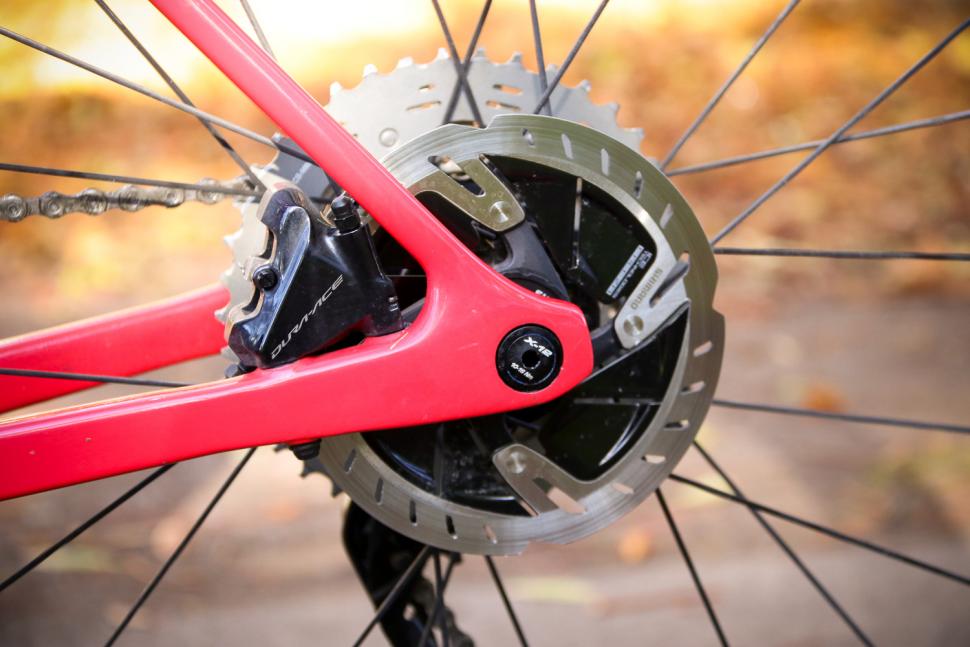

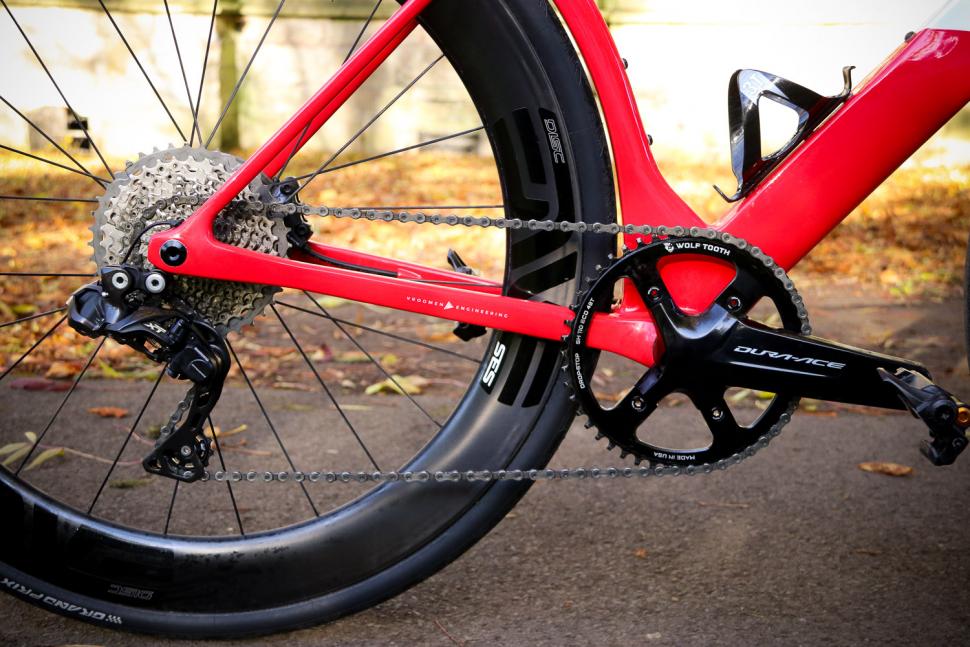

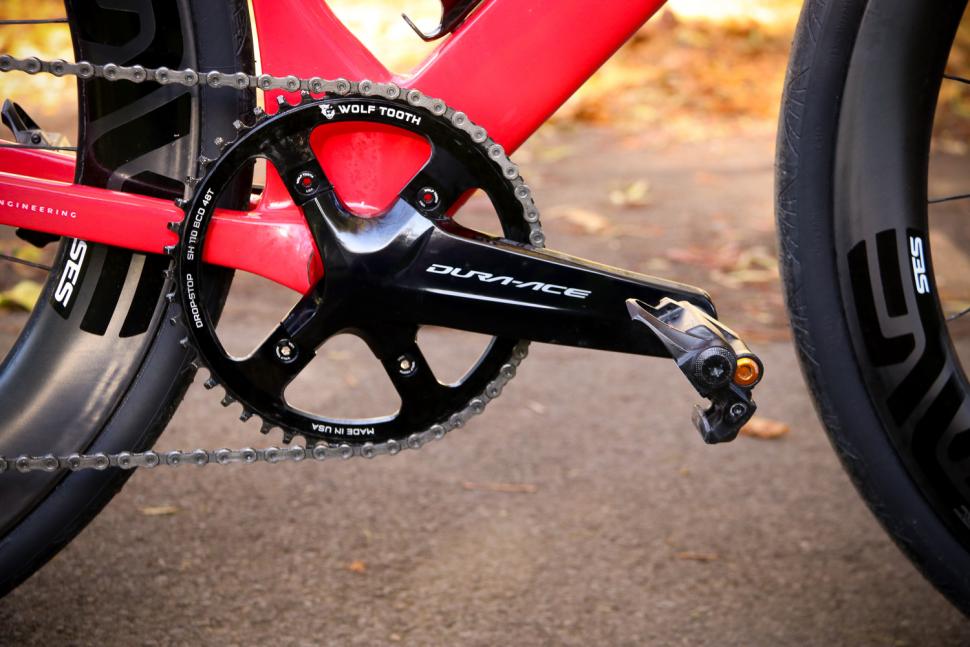

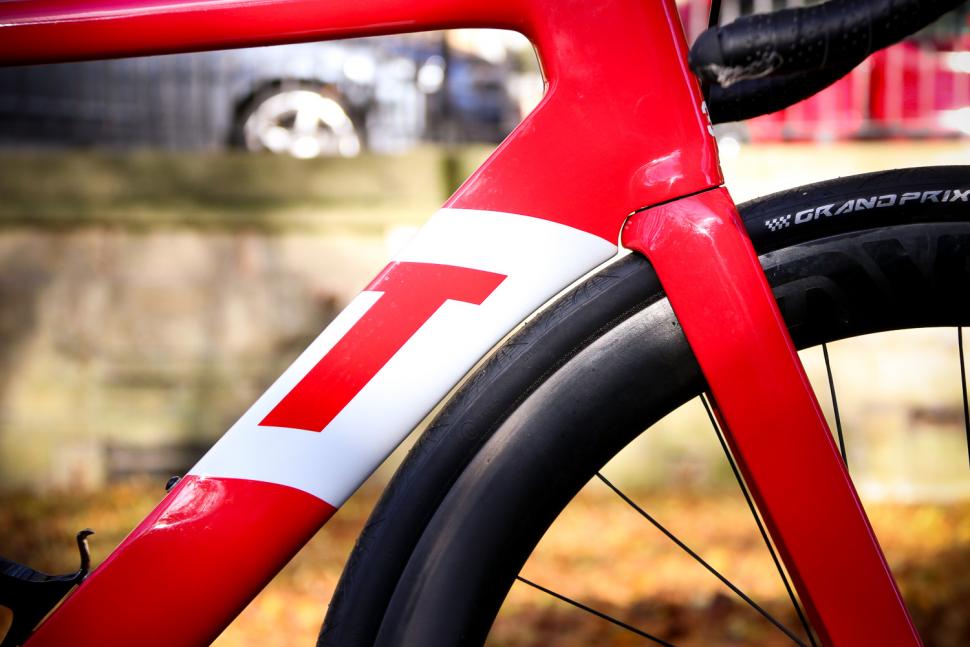
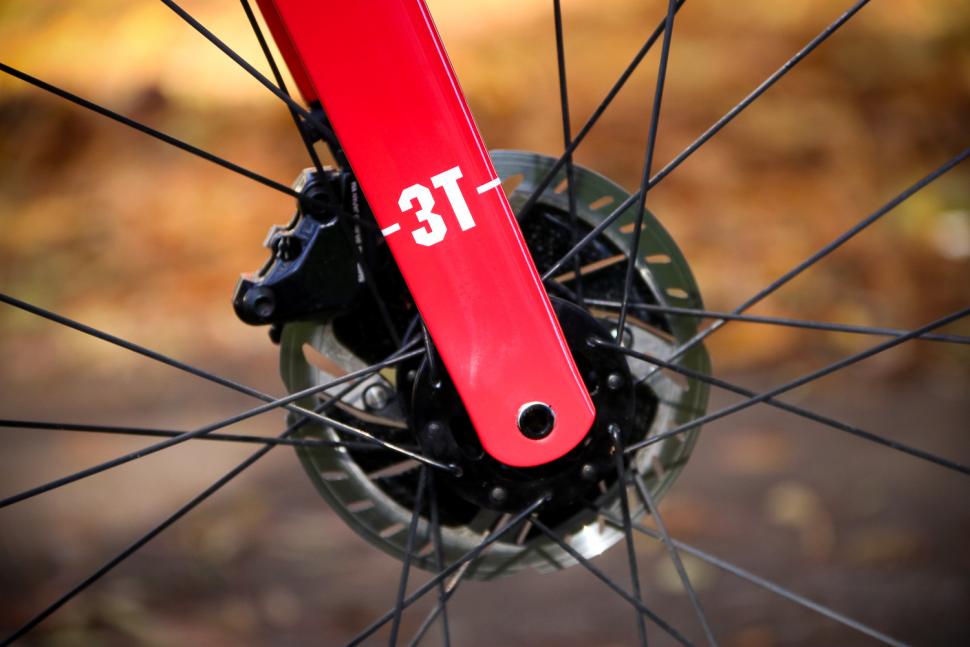
Add new comment
48 comments
This is clearly not my type of bike, but I have to admire it, couldn’t afford it either.
In terms of road use of 1* vs 2/3* for myself unlike on the MTB on road I tend around the middle of the gears, and having 1*9 on the commute bike, personally I’d love a 1* road bike at some point, clearly your mileage will vary!
OK, so we can't really sell them any more road bike stuff, and there are a lot of porky ex mountain bike and chubby sportive guys out there with lots of cash, what should we do ? I know ! We can put fat tyres, ridiculously low and high gears and other useless aero or suspension parts on. Kind of an aero/sportive/mountain bike thing. That should do the trick.
that red is going to clash with the Aqua Blue kit though
I can only think of the 1x as super marketing BS.
Surely the driver for 8 to 9 to 10 to 11 speed rear cassettes was so that we can be in exactly* the right gear all the time. i.e. narrower ratios between gears, letting you spin away at whatever is best for you.
I will be gobsmacked if Aqua Blue Sport, who've signed up to use this bike next year, run 1x in a mountain stage. The steps between one cassette offering full-tilt descent max gearing and something allowing Conor Dunne to grind up the steep bits will be very large.
I truly can't see past this problem - aero gains be damned.
Cat-1 problem - Neutral service wheels?
Would it kill them just to have the braze on mount for a frint mech? I've not tried it, but im not sold on this 1x system. The big jumps in gear ratios would annoy me too much.
I'd give 1x a try. 50 chainring with 11-42 cassette gives the exact same range as 50/34 11-28 (my normal combo). Comparing the ratios you admittedly lose 50x12 and 50x14 but the gaps are identical from 50x15 through 50x21 (probably where I spend most of my time). The gaps are larger at the top of the cassette but I'd be in the little chainring then anyway and happy to be able to rapidly lower the gearing. Huge dinner plate would look odd though
http://www.ritzelrechner.de/?GR=DERS&KB=34,50&RZ=11,12,13,14,15,17,19,21...
Everyone I speak to who's ridden 1x on the road thinks that to keep similar ratios of 2x (which most people will use) you either loose the smooth gear changes at the top or the bottom end.. personally I can't figure out which end I'd prefer to loose a smooth change of gears from.. living in a rolling landscape and riding local group club runs, I use 34/28 on the same ride I'll use 52/11 week in week out. Isn't that what 'most British cycle club riders' do also (unless you live in cambridgeshire).
In the media, I can't hear anyone saying.. 1x's great for a specific purpose but it's no good for the majority of british club riders. No-one seems to have anything negative to say about it.
Am I just being a luddite here, I've got a bike on order with 2x however there's an option for 1x, which I can quite easily change.. genuinely keen to understand. I'd like the 'advantages of 1x.. but I don't want to stitch myself up.
Should I be looking at 1x now and buy a change of front and rear cog's (and chain) to cope with various scenarios.. ?
The obvious thing with this bike is the 1X drivetrain, the review will obviously focus on this. It seems a little pointless to review it without the new 3T cassettes that the bike was designed with in mind. I hope you get it on there before the review is complete.
I like this bike (it seems a lot like my S5 with wider tyres), I think the drivetrain will be less of an issue with a road specific 1X cassette.
I still don't think it's time to ditch the front mech. There has been quite a lot of development in rear mechs over the years but the front mech is quite unchanged. Should companies not be developing and thinking more laterally with developing the front mech?
I'd say the reverse is true. Front mechs have actually been pretty interesting in the past couple generations.
The jump from, say, Shimano 105 5700 to 105 5800 was characterized by the latter's generational move to a longer arm. Having ridden bikes with both groupsets, the longer arm does reduce front shift effort at the left STI lever by a lot. The long arm did come with its own problems, though.
Now, with Dura-Ace R9100 and Ultegra R8000, we have a new design; 105 actually mimics their front mechs in the form of the new FD-5801. All three front mechs ditch the long arm design for something a little more discreet yet complicated, but they seem to have carried over the reduced front shift effort. It looks like the new design makes it easier for wider rear tire fitment.
There's no component with more lateral thought than the front derailleur, in fact that's all it is. A bunch of plates that push laterally.
It's a pretty rough component compared to the rear, I think there have been good developments, for example the move to electric shifting has improved the front more than the rear, but still it's a bunch of plates pushing. I don't see the industry putting much development into the front derailleur though, if 1x11 is not enough for everybody, I see more developments in changing the "11" than the "1" in that equation.
I like the idea of the 9-32 tooth cassette on a sub-compact 48/32. More top end than a 50/11 but easier bottom end than a 34/32 particularly for those of us who find really steep long hills particularly challenging as there are so few in the area I live in but do ride on occassion in sportives & audaxes. I know some of you will think if you cannot get up a hill with a 34/32 then you're not trying but being the wrong side of 55 some of us need all the help we can get...
I have been waiting for an announcement on a "complete" bike solution for the Strada 3T but sadly this is not what I was hoping for.
Take the Exploro. €3k for the frame. They also offer a build that is €3990 https://store.3tcycling.com/en/products/frames/exploro/exploro-team-complete-bike-536.html (Yes, I know, it doesn't have carbon wheels but that appears to be the main difference in build)
Strada frame is £3.6k. Plus the £3.85k for "bits bringing a total bike cost of £7,450! If that was with carbon stem/bars & some modified implementation of SRAM RED eTap then I could almost understand but this is an insane cost.
For compariosn sake, take the 2018 Canyon Aeroad CF SLX Disc 9.0 SL https://www.canyon.com/en-gb/road/aeroad/2018/aeroad-cf-slx-disc-9-0-sl.html.This has SRAM RED eTap & their lovely carbon integrated stem/bar. £5999.
I love the concept of the 3T but until there price comes in at a more sensible level then my next purchase won't be it (I plan to buy a bike next September for around 5k to tick the boxes of: Aero, carbon & integrated).
There are quite a few differences in build (Rival vs Force for example), but I hear you. Just keep in mind it also took about a year before we were able to do that EXPLORO build, it requires ramping up production quite significantly and some good preparation to do it well.
And yes, that changes the proposition for a lot of people, that's clear, even a few months after the introduction of the complete EXPLORO we see that €3990 for a complete Exploro is a magical price for many people. Not sure we can ever do that with the STRADA, it's just a much more complicated frame and fork, but it's not that we're not aware. That said, in many markets the STRADA is already sold out, so we're not complaining (except that we wish we could increase production quicker, but better to do it steadily).
I'm just not getting it at all.
Love it.
Can't afford it.
Just imagine the damage to the downtube should anything pointy get stuck in the front tyre.
Rather than imagining it, we tested it. Pick up of debris is quite rare. Similar to what you would find on a well-designed TT bike with a rear wheel cutout. Which of course is no surprise, since the gap is very similar in size, with the advantage that the way the cutout starts in the front sheds debris better.
This is of course provided people follow the tire size guidelines we have set. Ironically, with all our testing, the pro rides opted for wider tires than the amateurs. I've written some more info about that here: https://www.facebook.com/notes/3t-cycling/3-keys-to-strada-tire-clearanc...
Pages